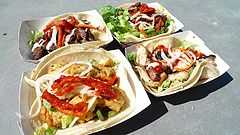Korean taco

Korean tacos are a Korean-Mexican fusion dish popular in a number of urban areas in the United States. Korean tacos originated in Los Angeles,[1] often as street food, consisting of Korean-style fillings, such as bulgogi and kimchi, placed on top of small traditional Mexican corn tortillas. Korean burritos are a similarly themed dish, using larger flour tortillas as a wrap.
Background
Although nearly any savory dish can and has been used as filling for a taco, burrito, or sandwich wrap, and other restaurants have occasionally served dishes they called Korean tacos,[2] the enduring popularity of the dish is generally traced to the use of Twitter by the proprietors of the Kogi Korean BBQ, a food truck in Los Angeles, California, to announce their schedule and itinerary.[3][4] The idea of making Korean tacos came to owner Mark Manguera after an unsuccessful search of Los Angeles' Koreatown for carne asada tacos.[4] In its first year of operation, Kogi generated an estimated $2 million of revenue.[5]
Korean taco trucks later appeared in Portland, Oregon (the "KOI Fusion" truck), Austin, Texas (the Chi'Lantro BBQ truck), and Seattle, Washington ("Marination Mobile", whose spicy pork Korean taco earned them Good Morning America's Best Food Truck in America).[6] In San Francisco the dish was popularized in 2009 by Namu Restaurant's Happy Belly food cart in Golden Gate Park, later moving to a farmers market food stand at the San Francisco Ferry Building.[7] The dish's popularity lead mainstream fast food chain Baja Fresh to test market Korean tacos as a menu item in California, with plans to introduce the dish to hundreds of locations nationwide.[8][9]
By 2010, restaurants and food trucks serving Korean tacos had appeared across the country including Austin, Chicago, St. Louis, and the East Coast of the United States.[10]
In April 2010, Food & Wine magazine named Roy Choi, the chef of the original Kogi's, one of its annual "Best New Chefs".[11] It was the first time a food truck chef had been nominated for the award.[12]
See also
- Korean-style carrot - a similar dish popular in post-Soviet states.
- Burrito
- KoMex
- Popiah
- Ssam
References
- ↑ Jane & Michael Stern (2009-11-15). "In Search of American Food".
- ↑ A restaurant in Santa Monica, California called "2424 Pico", for example, began using the name as early as 1996 for Korean fillings inside of a lettuce wrap. S. Irene Virbila (1996-09-01). "New Kids on the Block". Los Angeles Times.
- ↑ John Birdsall (2009-11-23). "Indian Taco Truck Curry Up Now Headed for San Francisco". SF Weekly.
- ↑ 4.0 4.1 Andrew Romano (2009-02-28). "Now 4 Restaurant 2.0: Thanks to Twitter and the Web, L.A. is obsessed with the Korean tacos of America's first viral eatery.". Newsweek.
- ↑ Joel Stein (2010-03-29). "Gourmet On the Go: Good Food Goes Trucking". Time Magazine.
- ↑ Matthew Amster-Burton (2009-05-28). "Korean Tacos Come in off the Street". Gourmet Magazine.
- ↑ John Birdsall (2009-07-23). "Namu's Asian Street Foods a Big Draw at Ferry Plaza's Thursday Market". SF Weekly.
- ↑ "Baja Fresh moves to start making Koji BBQ-style tacos". Brand X. 2009-07-20.
- ↑ Katy McLaughlin (2009-07-17). "Kogi Wars: Korean Taco Business Gets Ugly". Wall Street Journal.
- ↑ Edge, John T. (2010-07-27). "Korean-Style Tacos Move From West to East". The New York Times.
- ↑ Edwin Goei (2010-04-08). "Kogi's Roy Choi: One of Food and Wine Mag's Best New Chefs". Orange County Weekly.
- ↑ Betty Hallock (2010-04-06). "Food & Wine announces 'best new chefs'; Kogi's Roy Choi (big surprise) gets award". Los Angeles Times.